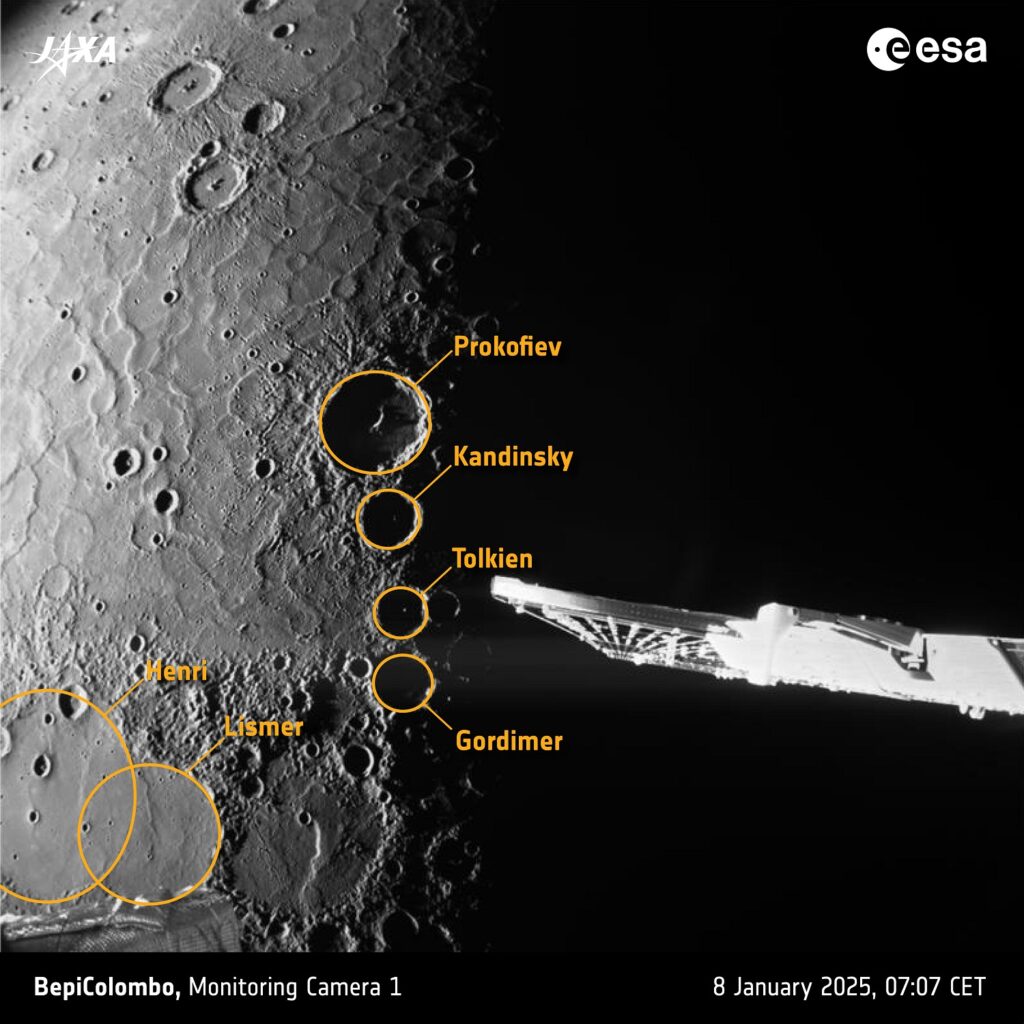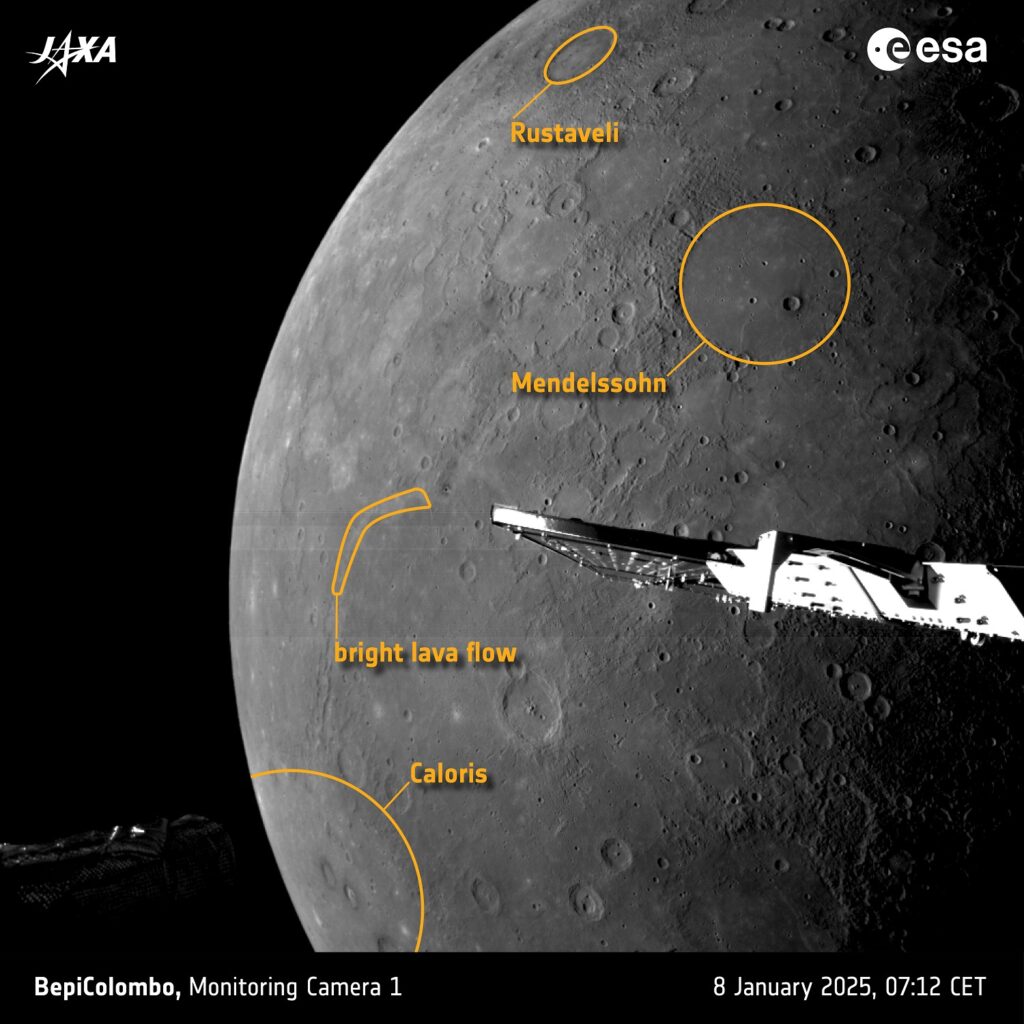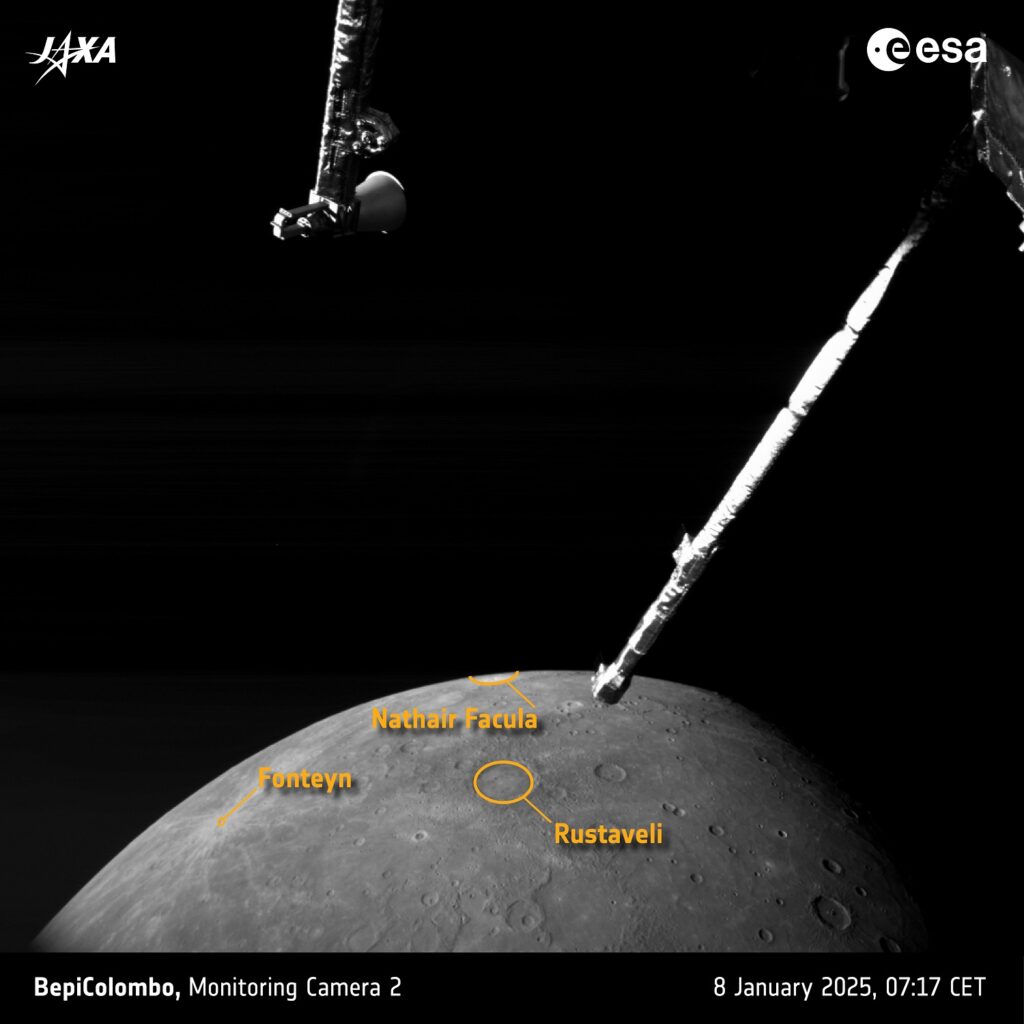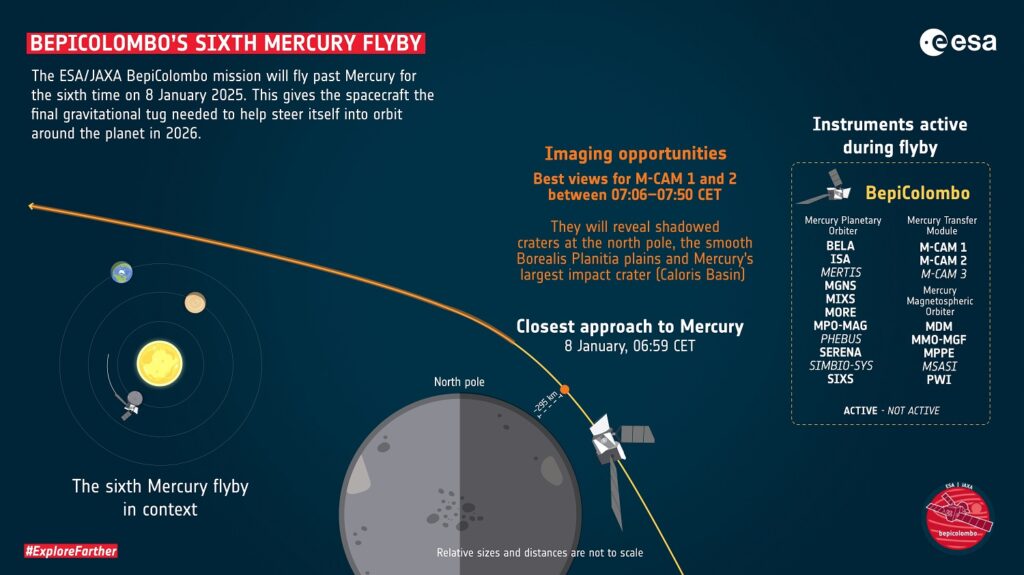OU News
News from The Open University
- Home
- BepiColombo swings by Mercury for the final time
BepiColombo swings by Mercury for the final time
Posted on • Science, Science, maths, computing and technology, Space

On 8 January 2025, the ESA/JAXA BepiColombo mission flew past Mercury for the sixth time, successfully completing the final ‘gravity assist manoeuvre’ needed to steer it into orbit around the planet in late 2026.
As with BepiColombo’s previous flybys, the spacecraft’s monitoring cameras (M-CAMs) did not disappoint.
“Wonderful to see”
David Rothery (Professor of Planetary Geosciences) and Jack Wright (Project Officer) from The Open University (OU) are both members of BepiColombo’s MCAM team. Jack travelled to the European Space Operations centre (ESOC) in Darmstadt, Germany for the flyby event and Dave made his contribution from the UK. He said:
“It meant getting up at 5.30 am, but once close up images stared to appear in our shared folder it was worth it. We had studied some simulated views in advance, and used these to devise our imaging strategy, but what we saw was better than expected. It was great looking down on Mercury’s north pole, and even seeing the sunlit tip of the central peak inside the crater Tolkien, whose floor is in permanent shadow.”
This flyby also marks the last time that the mission’s M-CAMs get up-close views of Mercury, as the spacecraft module they are attached to will separate from the mission’s two orbiters – ESA’s Mercury Planetary Orbiter and JAXA’s Mercury Magnetospheric Orbiter – before they enter orbit around Mercury in late 2026.
Jack added:
“This Mercury flyby has added personal significance for me. I made the world’s first geological map of Mercury’s Hokusai quadrangle as part of my Open University PhD studies. This region contains Nathair Facula and Rustaveli crater, seen together in the M-CAM2 image. Having written papers about both of them based on data from NASA’s MESSENGER mission, it is wonderful to see them beautifully imaged by BepiColombo.”
Let’s take a closer look at three images that the OU team worked on.
Peering into Mercury’s darkest craters

Mercury’s shadowy north pole revealed by M-CAM 1. Credit: ESA/BepiColombo/MTM
After flying through Mercury’s shadow, BepiColombo’s monitoring camera 1 (M-CAM 1) got the first close views of Mercury’s surface. Flying over the ‘terminator’ – the boundary between day and night – the spacecraft got a unique opportunity to peer directly down into the forever-shadowed craters at planet’s north pole.
The rims of craters Prokofiev, Kandinsky, Tolkien and Gordimer cast permanent shadows on their floors. This makes these unlit craters some of the coldest places in the Solar System, despite Mercury being the closest planet to the Sun!
Excitingly, there is existing evidence that these dark craters contain frozen water. Whether there is really water on Mercury is one of the key Mercury mysteries that BepiColombo will investigate once it is in orbit around the planet.
A surface shaped by impacts and lava
To the left of Mercury’s north pole in M-CAM 1’s view lie the vast volcanic plains known as Borealis Planitia. These are Mercury’s largest expanse of ‘smooth plains’ and were formed by the widespread eruption of runny lava 3.7 billion years ago.
This lava flooded existing craters, with wrinkles in the surface formed over billions of years following the solidification of the lava, probably in response to the planet contracting as its interior cooled down.

Mercury’s sunlit north viewed by M-CAM 1. Credit: ESA/BepiColombo/MTM
The flyby also provided views of the Caloris basin, Mercury’s largest well-preserved impact crater, which is the focus of a project recently begun by Chris Brooks who joined the OU as a full-time PhD student in October. On seeing these images Chris remarked:
“It’s beautiful to see Caloris again. It is great to be able to see up close a planet that there have previously been few opportunities to work on.”
Above a particularly large trough, a boomerang-shaped curve brightens the surface. This bright lava flow appears to connect to a deep trough below it. Yet another mystery that BepiColombo hopes to solve is which way this lava moved: into the Caloris basin, or out of it?
On Mercury, a bright surface is a young surface
Mercury is a remarkably dark planet. At a first glance the cratered planet may resemble the Moon, but its cratered surface only reflects about two-thirds as much light.
On this dark planet, younger features on the surface tend to appear brighter. Scientists don’t yet know what exactly Mercury is made of, but material brought up from beneath the outer surface gradually becomes darker with age.

Lava and debris brighten Mercury’s surface. Credit: ESA/BepiColombo/MTM
BepiColombo’s third image selected from this flyby, taken by M-CAM 2, shows spectacular examples of the two things that bring bright material to the surface: volcanic activity and large impacts. Prof Rothery added:
“We also had a glimpse of the Mercury’s explosive volcanic deposit, Nathair Facula, and the eruptive vent within it. This was right on the verge of what we expected to be able to make out, but having published on it based on images from the previous NASA mission to Mercury it was exciting to glimpse it again. It is a very important science target for several of Bepi’s instruments when we get into orbit because it offers our best chance to work out what it is about Mercury’s composition that has allowed explosive volcanic eruptions to continue through much of the planet’s history.”
And to the left lies the relatively young Fonteyn crater, which formed a ‘mere’ 300 million years ago.
Throughout its mission, several BepiColombo instruments will measure the composition of both old and new parts of the planet’s surface. This will teach us about what Mercury is made of, and how the planet formed.
Finishing in style
“BepiColombo’s main mission phase may only start two years from now, but all six of its flybys of Mercury have given us invaluable new information about the little-explored planet. In the next few weeks, the BepiColombo team will work hard to unravel as many of Mercury’s mysteries with the data from this flyby as we can,” concludes Geraint Jones, BepiColombo’s Project Scientist at ESA.

Credit: ESA
All M-CAM images will be made publicly available in the Planetary Science Archive.